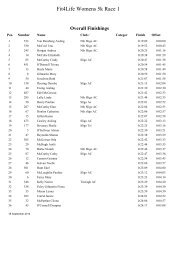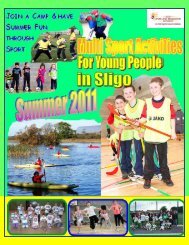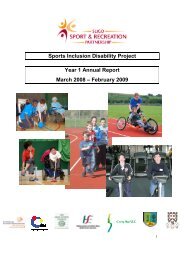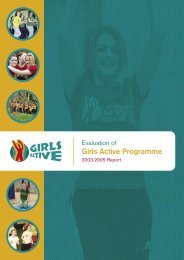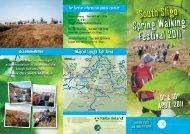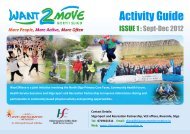SIDO Evaluation Executive Summary - Sligo Sport and Recreation ...
SIDO Evaluation Executive Summary - Sligo Sport and Recreation ...
SIDO Evaluation Executive Summary - Sligo Sport and Recreation ...
You also want an ePaper? Increase the reach of your titles
YUMPU automatically turns print PDFs into web optimized ePapers that Google loves.
<strong>Evaluation</strong> of the<strong>Sport</strong>s Inclusion Disability ProjectMarch 2008 – February 2010<strong>Executive</strong> <strong>Summary</strong>Author: Caroline Egan, B.B.S., M.B.S..Carmichael Centre for Voluntary GroupsOn behalf of <strong>Sligo</strong> <strong>Sport</strong> <strong>and</strong> <strong>Recreation</strong> Partnership
ContentsIntroduction 1<strong>Evaluation</strong> Methodology 2Key Findings 2Quantifiable Outputs 2Qualitative Data 41. Achieving the project’s aims <strong>and</strong> objectives 42. The Difference the Project has made to Participants 53. Support <strong>and</strong> Challenges to the Project 74. Project Providing Value for Money 85. Future Development of the Project 9Conclusions 11Recommendations 12IntroductionIn 2007, the Irish <strong>Sport</strong>s Council (ISC) was instrumental in establishing the <strong>Sport</strong>s Inclusion DisabilityProgramme. Funding was secured under the Dormant Accounts Fund (DAF) to employ a network oftwenty <strong>Sport</strong>s Inclusion Disability Officers (<strong>SIDO</strong>s) through Local <strong>Sport</strong>s Partnerships throughout thecountry. The overall funding allocated was just over €2 million in total for a two year period. The ISC, inconjunction with the Institute of Technology Tralee ensured that a support network was in place for the<strong>SIDO</strong>S through the establishment of the CARA Adapted Physical Activity Centre based on the IT Traleecampus.In <strong>Sligo</strong>, the <strong>SIDO</strong> was appointed by <strong>Sligo</strong> <strong>Sport</strong> <strong>and</strong> <strong>Recreation</strong> Partnership in March 2008 with theaim of increasing opportunities for people with disabilities to participate in sport <strong>and</strong> physical activity in<strong>Sligo</strong>, <strong>and</strong> to ensure local resources were used to best effect to facilitate inclusion in sport at local level.Significantly, additional local funding was received from SSRP partner agencies including County <strong>Sligo</strong>Vocational Education Committee, <strong>Sligo</strong> County Council, <strong>Sligo</strong> Borough Council <strong>and</strong> the Health Service<strong>Executive</strong>-West.<strong>Sligo</strong> <strong>Sport</strong> <strong>and</strong> <strong>Recreation</strong> Partnership contracted the Carmichael Centre for Voluntary Groups to carryout an evaluation of the two-year project in April 2010. This evaluation has been designed to provide athorough underst<strong>and</strong>ing of the work of the <strong>Sport</strong>s Inclusion Disability Project during its first two years ofoperation <strong>and</strong> to assess the impact of the project in <strong>Sligo</strong>.1<strong>Evaluation</strong> of the <strong>Sport</strong>s Inclusion Disability ProjectMarch 2008 – February 2010
<strong>Evaluation</strong> MethodologyThe evaluation process combined a review of local documentedevidence provided by the <strong>SIDO</strong> with primary research to assessthe impact of the project, with the results categorised into fivekey themes. The sequential steps involved in the evaluationprocess included:✲ Definition of the scope of the evaluation✲ Development of success indicators <strong>and</strong> their measures✲ Collection of evaluation data✲ Analysis <strong>and</strong> interpretation of data collected✲ Presentation of evaluation resultsKey FindingsRespondents commented on the significant numbers of people who have benefited from the programming,events, <strong>and</strong> the training <strong>and</strong> education opportunities offered to schools, clubs, facility providers <strong>and</strong>disability organisations by the <strong>SIDO</strong> project. The positive impact on social capital was also noted, aswas the benefit of having a dedicated <strong>Sport</strong>s Inclusion Disability Officer available to provide advice <strong>and</strong>support with respect to increasing opportunities for people with disabilities to participate in sporting <strong>and</strong>recreational activities. This was considered particularly important given that many disability organisations<strong>and</strong> groups do not possess adequately experienced personnel in the area of sport <strong>and</strong> physical activityfor people with disabilities.Quantifiable OutputsEight performance indicators were set for the project. The results achieved by the end of Year 2 for eachperformance indicator are listed on page 3. The results were collated from the documentation provided bythe <strong>SIDO</strong> which was analysed as part of this evaluation.2 <strong>Sligo</strong> <strong>Sport</strong> <strong>and</strong> <strong>Recreation</strong> Partnership
1INDICATOR23456780 people with a disability to be engaged in targeted activity programmesYear 1:Year 2:Total:65 participants in targeted programmes40 additional participants in targeted programmes105 participants (25 participants more than target figure)10 people with a disability to be integrated into sports clubs of their choice ata meaningful levelYear 1: 22 participantsYear 2: 22 participants (same participants as Year 1)Total: 22 participants (12 participants more than the target figure)3 new clubs established or 3 established clubs supported to engage with 20people with physical/sensory/learning disabilitiesYear 1: 5 sports clubsYear 2: 5 sports clubs (same clubs as Year 1)Total: 5 sports clubs (2 more than the target figure for sports clubs)<strong>Sport</strong>s inclusion policies developed within 4 clubsYear 1:Year 2:Total:1 club0 clubs1 club (3 less than the target figure for clubs)60 people involved in education /training/awareness workshopsYear 1:Year 2:Total:80 participants106 additional participants186 participants (126 participants more than the target figure)2 local fitness/gym centres identified <strong>and</strong> promoted as models of goodpractice in terms of accessibility for people with a disabilityYear 1: 2 centresYear 2: 2 centres (same centres as Year 1)Total: 2 centres (performance indicator on target)8 quality promotional features in various mediaYear 1:Year 2:Total:11 features13 features24 features (16 features more than the target figure)8Quarterly meetings of the <strong>Sport</strong>s Disability ForumYear 1:Year 2:Total:3 meetings1 meeting4 meetings (4 meetings less than the target figure)The outputs achieved for each of the performance indicators shows a very clear trend. Activities related torecruiting <strong>and</strong> engaging people with disabilities to participate in sports was highly successful <strong>and</strong> greatlyexceeded expectations. The figures presented for training <strong>and</strong> education also exceeded original targets.Target for marketing <strong>and</strong> promotion related activities were successful. On a less positive note, activitiesrelated to supporting policy development within clubs performed below expectations, as did participationin the sports disability forum.3<strong>Evaluation</strong> of the <strong>Sport</strong>s Inclusion Disability ProjectMarch 2008 – February 2010
1.4 NetworkingRespondents felt that the project has provided a constructive format in which working collaboratively <strong>and</strong>exchanging information between statutory <strong>and</strong> voluntary groups can take place. The <strong>SIDO</strong> establishedstrong links with Learning Disability Services, the Physical <strong>and</strong> Sensory Disabilities Department <strong>and</strong>the Mental Health Services of the HSE. The <strong>SIDO</strong> is also a member of the <strong>Sligo</strong> Disability Network,an interagency group which includes members from all of the local organisations involved in disabilityprovision in <strong>Sligo</strong>.1.5 Promotion <strong>and</strong> Disability Awareness RaisingClearly, a key outcome of the project is the increased awareness of sport for people with disabilities.In identifying participants, the project targeted all disability services in <strong>Sligo</strong>, organised an initial Come <strong>and</strong>Try <strong>Sport</strong>s Ability Day <strong>and</strong> contacted people with disabilities directly through their relevant organisations.The project further generated awareness of its work through local media outlets namely the local radiostation, press releases in local papers, promotion <strong>and</strong> information on the SSRP website, features in theCARA newsletter <strong>and</strong> annual reports. This effective communication has directly impacted on the levels ofawareness of opportunities to participate in sport by people with a disability.2. The Difference the Project has made to ParticipantsBased on responses, participants clearly feel that there is a significant increase in participationin sports by people with disabilities <strong>and</strong> a much greater level of awareness around disabilitysport in general.2.1 ProgrammingThe project has facilitated the development of a broad range of programming to suit people of all ages withdiffering disabilities. An example provided was the t<strong>and</strong>em cycling initiative, whereby t<strong>and</strong>em bikes havebeen made available for people with visual impairments <strong>and</strong> t<strong>and</strong>em pilots from the Innisfree WheelersCycling Club were identified <strong>and</strong> trained to implement the programme One visually impaired t<strong>and</strong>em cyclistwho has benefited from this initiative commented “T<strong>and</strong>em cycling has given me, <strong>and</strong> I speak fromthe perspective of a visually impaired person, an opportunity to actively participate in an outdoorsport which might otherwise be denied to me. The provision of a t<strong>and</strong>em bike <strong>and</strong> pilot has enabledme to attain a high level of fitness which, for a guy in his mid-40’s, is not a bad thing at all. Mostsignificantly of all though, participating in the 2009 cycle from Mizen Head to Malin Head in aid ofIrish Guide Dogs marked a major milestone in my life. I fully intend to continue t<strong>and</strong>em cycling <strong>and</strong>try to maintain a level of fitness which will enable me to take part in next year’s Mizen to Malin also.My guide dog has given me back a lot of my independence <strong>and</strong> cycling has allowed me to be an equalparticipant in an event which is more than 430 miles long <strong>and</strong> takes 6 days to complete. Cycling fromMizen Head to Malin Head has allowed me to give something back, in a meaningful way, to IrishGuide Dogs”Respondents strongly emphasised the fact that prior to the project commencing, such opportunities didnot exist. During the course of meetings <strong>and</strong> interviews the activities that participants had most benefitedfrom <strong>and</strong> enjoyed included: T<strong>and</strong>em Cycling, Boccia, Walking, Kurling, Aerobics, Swimming, Archery,Spinning <strong>and</strong> the Come <strong>and</strong> Try <strong>Sport</strong>s Ability Days.5<strong>Evaluation</strong> of the <strong>Sport</strong>s Inclusion Disability ProjectMarch 2008 – February 2010
3. Support for <strong>and</strong> Challenges to the ProjectRespondents perceived a number of supports that helpedfacilitate the achievement of key outputs <strong>and</strong> outcomesalong with a number of challenges to the project.3.1 Supports<strong>Sligo</strong> <strong>Sport</strong> <strong>and</strong> <strong>Recreation</strong> PartnershipThe project fits very well with the <strong>Sligo</strong> <strong>Sport</strong> <strong>and</strong> <strong>Recreation</strong>Partnership strategy for making sport <strong>and</strong> recreation a way oflife in <strong>Sligo</strong>. Prior to the establishment of <strong>SIDO</strong> project, somework was carried out on inclusion <strong>and</strong> a disability strategy was developed. At a strategic level the Boardof Directors of SSRP supports the project while the SSRP Co-ordinator helps inform <strong>and</strong> guide projectplanning. The project is regularly discussed at SSRP staff meetings thereby ensuring that the <strong>Sport</strong>sInclusion Disability Project activities are linked into all SSRP sports development <strong>and</strong> active communities’strategies <strong>and</strong> initiatives.Local Stakeholder SupportIt was evident from respondents that the project received meaningful support from a host of locally basedstakeholders including: local disability groups, Irish Wheelchair Association, local sports clubs, gyms <strong>and</strong>schools. Financial support from County <strong>Sligo</strong> Vocational Education Committee, <strong>Sligo</strong> County Council, <strong>Sligo</strong>Borough Council <strong>and</strong> Health Service <strong>Executive</strong> West (HSE-W) was significant. It was noted that the projectreceived in kind benefit from the Institute of Technology <strong>Sligo</strong> with respect to volunteer recruitment <strong>and</strong>training. Engagement with the <strong>Sligo</strong> Disability Network facilitated by <strong>Sligo</strong> Leader Partnership Companyprovides a worthwhile platform for networking.North West Disability Advisory GroupThrough the establishment of the North West Disability Advisory Group for the <strong>Sligo</strong> <strong>and</strong> Donegal areathere has been clear <strong>and</strong> effective communication, sharing of ideas <strong>and</strong> resources <strong>and</strong> greater awareness<strong>and</strong> underst<strong>and</strong>ing of the key issues surrounding the development of sport <strong>and</strong> active recreation forpeople with disabilities in the North West. This group has provided a very practical support for the projectover its duration.CARA Adapted Physical Activity Centre <strong>and</strong> the Irish <strong>Sport</strong>s CouncilThrough funding from the Irish <strong>Sport</strong>s Council, the CARA Adapted Physical Activity Centre has been asource of guidance to the project, through direct support <strong>and</strong> training provided to all <strong>Sport</strong>s InclusionDisability Officers (<strong>SIDO</strong>s) nationwide. CARA has been involved in the training <strong>and</strong> professionaldevelopment of all <strong>SIDO</strong>s <strong>and</strong> arranged national meetings, which proved beneficial for the sharing of ideas<strong>and</strong> information. The ‘Games for All’ training provided by the Centre was very beneficial to the project. TheCARA Centre also provided training with respect to disability awareness, inclusion, <strong>and</strong> adapted games.Recognising the value of the project in 2010, the Irish <strong>Sport</strong>s Council has part-funded the <strong>SIDO</strong> positionsin 17 Local <strong>Sport</strong>s Partnerships based on matched funding locally.3.2 ChallengesProject Engagement <strong>and</strong> Public PerceptionsEngaging with people with disabilities <strong>and</strong> their families was a big challenge from the outset. The <strong>SIDO</strong>has used a variety of methods to encourage people with disabilities (<strong>and</strong> their carers) to get involved inthe project. These included engaging directly with disability organisations, community & voluntary groups,schools <strong>and</strong> clubs as well as issuing regular press releases <strong>and</strong> utilising the SSRP <strong>and</strong> CARA websites.7<strong>Evaluation</strong> of the <strong>Sport</strong>s Inclusion Disability ProjectMarch 2008 – February 2010
5. Future Development of the ProjectRespondents indicated that it was vital the project shouldcontinue for the health, well-being <strong>and</strong> social benefits itoffers to people with disabilities. It was further noted thatthrough the networks <strong>and</strong> partnerships established, thesharing of local resources were used to best effect for thebenefit of the participants engaged in the <strong>SIDO</strong> project. Itwas suggested that future objectives of the project shouldinvolve policy development in the areas of volunteering <strong>and</strong>inclusion; <strong>and</strong> by making the role more strategic rather thanoperational.Respondents indicated that the project should be sustained<strong>and</strong> exp<strong>and</strong>ed as levels of participation continue to grow.However, national objectives may change <strong>and</strong> the projectwill have to become self-sustainable. In addition, as theexternal environment changes it will require that the project responds. One person noted that: “The briefis not just sport. It’s social inclusion.” This being the case, it was suggested that to secure funding, thebrief of the project could be broadened to reflect a wider remit than sport <strong>and</strong> physical activity for peoplewith disabilities.Some of the respondents commented that in continuing the project the focus should be on “abilities.” Oneperson noted: “Small kids accept people with disabilities readily. Start at pre-school. School sportsdays should focus on all kids, <strong>and</strong> show abilities of people with disabilities. Teachers need greaterlevels of awareness. Ways of adapting games to accommodate everybody…Special needs games needto be developed that can be applied to all. People with disabilities are the starting point rather thanthe other way round.”5.1 Evolution of the role of the <strong>Sport</strong>s Inclusion Disability OfficerIt was noted that initially, the <strong>SIDO</strong>’s role had been h<strong>and</strong>s-on with a focus on five sports. However, notall local needs are the same with respect to these sports <strong>and</strong> so a number of different sports activitieswere also developed. The role may evolve over time to become more strategic in nature, with the <strong>SIDO</strong>having a co-ordinating role within the county with respect to developing sporting opportunities for peoplewith disabilities. This would place even greater emphasis on working closely with partners, rather thanon focusing on the delivery of programming. Over time, this strategic role will help to develop a “model ofinclusion” for adapted physical activity.A respondent also commented that the role within the project may also extend beyond disability in directresponse to the needs of organisations that may provide match funding for the project in the future.5.2 Sustainability of the ProjectSeveral issues were raised by respondents with respect to the sustainability of the project. The fundingissue was a common thread that underpinned feedback. Specifically, it was noted that project fundingceased at the end of February 2010, at which point the Irish <strong>Sport</strong>s Council made funds available withmatch funds coming from the HSE, <strong>Sligo</strong> County Council, <strong>Sligo</strong> Borough Council, County <strong>Sligo</strong> VEC <strong>and</strong><strong>Sligo</strong> <strong>Sport</strong> <strong>and</strong> <strong>Recreation</strong> Partnership. In order for the project to continue into the future it will benecessary for all of these funding sources to remain committed to the project. It was also noted thatalthough participants contribute to programmes costs, this contribution is minimal i.e. charges coverapproximately half of the cost in many instances. It was suggested that: “If funders want intervention atground level for people with disabilities, then this project must be kept going. As things become moremainstreamed the funding may diminish.”9<strong>Evaluation</strong> of the <strong>Sport</strong>s Inclusion Disability ProjectMarch 2008 – February 2010
It was noted that the challenge still remains to bring peoplewith disabilities into mainstream sports clubs <strong>and</strong> activities.However, a number of local sports clubs, predominantlyinvolving minority sports have fully integrated people withdisabilities as members. The environment also needs to becreated for bigger sporting organisations <strong>and</strong> sports clubs toembrace inclusion <strong>and</strong> increase opportunities for people withdisabilities to access these sports locally. One stakeholdercommented: “Disability sports should not be somethingspecialised, but should be totally inclusive.”It was also noted that the project needs to continue as “There can be big problems for people isolatedat home who find it difficult even to talk to other people. Accessing sport <strong>and</strong> recreation gives peoplethe confidence to take on other activities.”With respect to the levels of motivation to participateby people with disabilities, it was suggested: “Thereis a need for a significant campaign nationally.Target people with disabilities, <strong>and</strong> society ingeneral. Target people in specific settings suchas schools.” This message was also reinforcedby another stakeholder who commented that:“The media tend to promote disability events,but rarely in the sports section. The emphasisin media tends to be Disability. Needs a morepositive spin. Need for more education of themedia.” It was felt that continuing the project wouldplay an integral part in providing a resource for themedia to access information.The need for raising the awareness levels amongst the general public in relation to sport for people witha disability was further highlighted with one respondent pointing out: “The awareness-raising role hasto be sustained. Awareness-raising doesn’t get cracked in a few years. Career opportunities for somepeople with disabilities could be looked at through this programme. It is also important to continue todevelop the network of stakeholders already involved.”Finally, in relation to the centres in which activities are run, one person noted that there needs to be moresupport from staff in these centres. Hence, there is an on-going role for the project to build capacity withincentres through continued training <strong>and</strong> education opportunities.5.3 Future development of sports <strong>and</strong> recreation activitiesAs the availability of increased opportunities for sports <strong>and</strong> physical activities for people with disabilitieshas been a feature of the project, respondents were asked what if any, additional sports or recreationalactivities would they like to see the project introduce in the future. The answers included:✲ Track <strong>and</strong> Field events.✲ Additional Aerobics programmes.✲ More ‘Come <strong>and</strong> Try’ days.✲ Swimming.✲ All of the activities on the ‘Come <strong>and</strong> Try’ days available throughout the year.✲ Table Tennis <strong>and</strong> Basketball.✲ Spinning Classes.✲ Gym <strong>and</strong> Leisure Centre Facilities.10 <strong>Sligo</strong> <strong>Sport</strong> <strong>and</strong> <strong>Recreation</strong> Partnership
Conclusions✲ The <strong>Sport</strong>s Inclusion Disability Project has had significant physical, psychological <strong>and</strong> social healthbenefits on programme participants.✲ Opportunities for people with disabilities to participate in sporting <strong>and</strong> active recreational activitiesin <strong>Sligo</strong> have greatly increased.✲ Management <strong>and</strong> delivery of the <strong>SIDO</strong> project by <strong>Sligo</strong> <strong>Sport</strong> <strong>and</strong> <strong>Recreation</strong> Partnership ensuredpre-existing expertise, collaborative working <strong>and</strong> networks could be fully utilised by the project.✲ Financial <strong>and</strong> In-kind support from key partners including the Irish <strong>Sport</strong>s Council, CARA APACentre, County <strong>Sligo</strong> VEC, HSE, <strong>Sligo</strong> County Council <strong>and</strong> <strong>Sligo</strong> Borough Council was critical to thesuccess of the project.✲ Developing co-ordinated working relationships with over fifty local organisations <strong>and</strong> groupsworking with people with disabilities has resulted in a wider target audience being reached(Intellectual, physical <strong>and</strong> sensory, mental health, medical difficulties).✲ Capacity-building of local coaches, teachers, sports leaders, students <strong>and</strong> volunteers has beenincreased through the provision of education <strong>and</strong> training focusing on disability awareness <strong>and</strong>inclusion through sport.✲ Inclusion of people with disabilities into sport was particularly effective through engagement withsport clubs, particularly through the five mainstream sports clubs in Archery, Athletics, Cycling,Sailing <strong>and</strong> Table Tennis.✲ The profile of sport <strong>and</strong> physical activity for people with disabilities in <strong>Sligo</strong> has been enhancedthrough effective promotion of the project (SSRP <strong>and</strong> CARA websites, press releases, radiointerviews, progress reports, presentations).✲ Value for money was achieved when comparing the total project funding with the significant numberof participants involved in activities <strong>and</strong> the significant health benefits they experienced.In conclusion, it is very evident fromthe documented evidence <strong>and</strong> feedbackfrom all the various stakeholders that theproject has provided outst<strong>and</strong>ing supportto people with disabilities, their families<strong>and</strong> carers who wish to engage in sport<strong>and</strong> recreational activity at a level of theirchoice.11<strong>Evaluation</strong> of the <strong>Sport</strong>s Inclusion Disability ProjectMarch 2008 – February 2010
Recommendations✲ Every effort should be made to continue the <strong>Sport</strong>sInclusion Disability Project beyond the initial twoyear phase in order to sustain the momentumin <strong>Sligo</strong> with respect to programming, capacitybuilding,training, promotion <strong>and</strong> the on-goingdevelopment of opportunities for people with adisability to engage in sport <strong>and</strong> active recreation.✲ The need to develop a collective funding strategy forthe <strong>SIDO</strong> national network, led by the Irish <strong>Sport</strong>sCouncil in conjunction with LSP’s <strong>and</strong> the CARAAPA centre needs to be addressed.In addition, a commitment of funding from LocalStatutory Agencies needs to maintained for thesustainability of the project.✲ <strong>Sligo</strong> <strong>Sport</strong> <strong>and</strong> <strong>Recreation</strong> Partnership is ideally positioned to manage <strong>and</strong> deliver a co-ordinatedapproach to the ongoing inclusion of people with a disability into sport <strong>and</strong> physical activity.Through ongoing collaboration with local disability organisations <strong>and</strong> services the needs of theclients will be clearly established <strong>and</strong> will help inform the work of the <strong>SIDO</strong>.✲ The future role of the <strong>Sport</strong>s Inclusion Disability Officer needs to move from an action orientatedfocus to being more strategic in nature. This will enable the <strong>SIDO</strong> to engage with the generalpopulation, sports clubs, leisure centres <strong>and</strong> community organisations on addressing strategicissues <strong>and</strong> policy development. Furthermore, a focus on engaging with mainstream sports clubs <strong>and</strong>facilities to ensure project sustainability is required.✲ Positive partnership <strong>and</strong> co-ordinated working relationships with local agencies (including theHealth Service <strong>Executive</strong>, <strong>Sligo</strong> County Council, <strong>Sligo</strong> Borough Council, County <strong>Sligo</strong> VocationalEducation Committee) needs to be sustained whilst opportunities to work with new partnersincluding local development companies should be explored.✲ A volunteer management programme should be considered that concentrates on the delivery ofcertain activities by volunteer managers. This would maximise the potential for participants toengage in targeted programmes, events, <strong>and</strong> training.✲ Capacity-building through education <strong>and</strong> training in disability awareness <strong>and</strong> inclusion needs tocontinue. This will further empower local coaches, teachers, sports leaders <strong>and</strong> volunteers toprovide quality sporting <strong>and</strong> recreational opportunities to people with disabilities in <strong>Sligo</strong>.✲ A communication strategy that deals with perception of people with disabilities participating insport should be developed. An element of this strategy should look at maintaining <strong>and</strong> streamliningcurrent participant, organisation <strong>and</strong> volunteer databases to ensure a more efficient system ofdisseminating information. In addition, a Customer Relationship Management system should besourced that enables the project to maintain a personalised level of contact with stakeholders.Complete <strong>SIDO</strong> project report available on www.sligosport<strong>and</strong>recreation.ie12 <strong>Sligo</strong> <strong>Sport</strong> <strong>and</strong> <strong>Recreation</strong> Partnership
Contact Details:Shane Hayes,<strong>Sport</strong>s Inclusion Development Officer,<strong>Sligo</strong> <strong>Sport</strong> <strong>and</strong> <strong>Recreation</strong> Partnership,VEC Offices, Riverside, <strong>Sligo</strong>.Tel: 071 9161511Fax: 071 9143093Email: shane@sligosport<strong>and</strong>recreation.ieWeb: www.sligosport<strong>and</strong>recreation.ie



